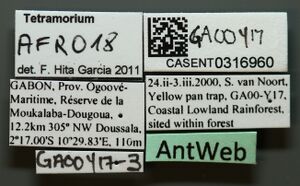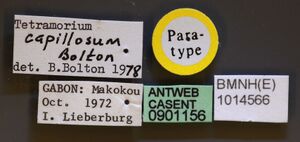Tetramorium capillosum
| Tetramorium capillosum | |
|---|---|

| |
| Scientific classification | |
| Kingdom: | Animalia |
| Phylum: | Arthropoda |
| Class: | Insecta |
| Order: | Hymenoptera |
| Family: | Formicidae |
| Subfamily: | Myrmicinae |
| Tribe: | Crematogastrini |
| Genus: | Tetramorium |
| Species: | T. capillosum |
| Binomial name | |
| Tetramorium capillosum Bolton, 1980 | |
Tetramorium capillosum presumably lives in the leaf litter and/or on the ground. It has been found at elevations from 40 to 1081 m.
Identification
A member of the Tetramorium capillosum species complex, which is part of the Tetramorium tortuosum species group.
Hita Garcia and Fisher (2013) - The following character combination clearly distinguishes T. capillosum from the remainder of the species group: eyes of moderate size (OI 23 - 25); antennal scapes moderately long (SI 80 - 83); petiolar node nodiform with anterodorsal and posterodorsal margins relatively rounded, posterodorsal margin situated higher than anterodorsal margin, dorsum convex; mandibles unsculptured, smooth, and shining; petiole and postpetiole usually with weak sculpture; whole body uniformly very dark brown to black.
T. capillosum differs from Tetramorium hecate and Tetramorium tabarum in overall body size and colouration. The latter two are smaller species (WL 0.69 - 0.83; PW 42 - 52) either bicoloured or of uniform brown colour, whereas T. capillosum is noticeably larger (WL 1.02 - 1.19; PW 60 - 68) and of a very dark brown to black colour. However, both body size and colouration are often variable within the genus Tetramorium. Tetramorium capillosum also differs from T. hecate in antennal scape length, eye size, and petiolar node shape. In T. capillosum the antennal scapes are moderately long (SI 80 - 83), eyes are of moderate size (OI 24 - 25), and the petiolar node has anterodorsal and posterodorsal margins that are relatively rounded, with the posterodorsal margin situated higher than the anterodorsal. In contrast, T. hecate scapes are relatively short (SI 73 - 77), eyes are relatively large (OI 27 - 31), and the petiolar node is rectangular nodiform with anterodorsal and posterodorsal angles sharply defined and at about the same height. Furthermore, T. tabarum significantly varies from T. capillosum in eye size, propodeal spine length, and sculpture on mandibles and postpetiole. Tetramorium tabarum has much larger eyes (OI 27 - 31), much shorter spines (PSLI 22 - 25), and the mandibles and the postpetiole are unsculptured, whereas T. capillosum has smaller eyes (OI 24 - 25), much longer spines (PSLI 31 - 43), and conspicuously sculptured mandibles and postpetiole.
Despite a relatively broad distribution range from the Gulf of Guinea to northwest Uganda, Tetramorium capillosum remains morphologically remarkably stable without noticeable intraspecific variation.
Keys including this Species
Distribution
Currently, T. capillosum is found throughout Gabon, southern Cameroon, eastern Central African Republic, and then much further east in the northeastern Democratic Republic of Congo and northwestern Uganda. As noted above, the disjunctive range is almost certainly due to a sampling artefact, and it is very likely that T. capillosum is also encountered in Congo, and in much more of the Democratic Republic of Congo than just the northeastern locality of Epulu. Also, it seems unlikely that the species does not occur in Equatorial Guinea since it is found further north, south, and east, and was likely missed due to a sampling artefact. (Hita Garcia and Fisher 2013)
Latitudinal Distribution Pattern
Latitudinal Range: 3.383333333° to -2.4227°.
| North Temperate |
North Subtropical |
Tropical | South Subtropical |
South Temperate |
- Source: AntMaps
Distribution based on Regional Taxon Lists
Afrotropical Region: Cameroon, Central African Republic, Gabon (type locality), Uganda.
Distribution based on AntMaps
Distribution based on AntWeb specimens
Check data from AntWeb
Countries Occupied
| Number of countries occupied by this species based on AntWiki Regional Taxon Lists. In general, fewer countries occupied indicates a narrower range, while more countries indicates a more widespread species. |

|
Estimated Abundance
| Relative abundance based on number of AntMaps records per species (this species within the purple bar). Fewer records (to the left) indicates a less abundant/encountered species while more records (to the right) indicates more abundant/encountered species. |

|
Biology
Castes
Images from AntWeb
   
| |
| Worker. Specimen code casent0316960. Photographer Shannon Hartman, uploaded by California Academy of Sciences. | Owned by CAS, San Francisco, CA, USA. |
   
| |
| Worker. Specimen code casent0405973. Photographer Shannon Hartman, uploaded by California Academy of Sciences. | Owned by CAS, San Francisco, CA, USA. |
   
| |
| Paratype of Tetramorium capillosum. Worker. Specimen code casent0901156. Photographer Will Ericson, uploaded by California Academy of Sciences. | Owned by NHMUK, London, UK. |
Nomenclature
The following information is derived from Barry Bolton's Online Catalogue of the Ants of the World.
- capillosum. Tetramorium capillosum Bolton, 1980: 236, fig. 13 (w.) GABON.
Unless otherwise noted the text for the remainder of this section is reported from the publication that includes the original description.
Description
Worker
Hita Garcia and Fisher (2013) - (N=12) HL 0.79 - 0.89 (0.84); HW 0.76 - 0.84 (0.79); SL 0.62 - 0.69 (0.65); EL 0.18 - 0.21 (0.19); PH 0.41 - 0.51 (0.46); PW 0.60 - 0.68 (0.65); WL 1.02 - 1.19 (1.12); PSL 0.26 - 0.38 (0.30); PTL 0.31 - 0.37 (0.34); PTH 0.34 - 0.41 (0.37); PTW 0.28 - 0.33 (0.31); PPL 0.28 - 0.33 (0.30); PPH 0.37 - 0.43 (0.40); PPW 0.37 - 0.44 (0.41); CI 94 - 96 (95); SI 80 - 83 (82); OI 23 - 25 (24); DMI 55 - 62 (58); LMI 39 - 43 (41); PSLI 31 - 43 (35); PeNI 45 - 49 (47); LPeI 89 - 100 (94); DPeI 86 - 94 (89); PpNI 61 - 66 (63); LPpI 70 - 78 (75); DPpI 130 - 139 (135); PPI 127 - 138 (134).
Head longer than wide (CI 94 - 96); posterior head margin moderately concave. Anterior clypeal margin entire and convex. Frontal carinae strongly developed, approaching or ending at posterior head margin. Antennal scrobes narrow but very well-developed with clearly defined margins all around. Antennal scapes moderately long, not reaching posterior head margin (SI 80 - 83). Eyes of moderate size (OI 23 - 25). Mesosomal outline in profile weakly convex, moderately marginate from lateral to dorsal mesosoma; promesonotal suture and metanotal groove absent; mesosoma comparatively stout and high (LMI 39 - 43). Propodeal spines relatively long to very long, spinose, and acute (PSLI 31 - 43); propodeal lobes short, triangular to elongate-triangular, and usually acute. Petiolar node in profile rectangular nodiform, approximately as high as long to weakly higher than long (LPeI 89 - 100), anterior and posterior faces approximately parallel, posterodorsal margin situated higher than anterodorsal, anterodorsal and posterodorsal angles relatively rounded, petiolar dorsum convex; node in dorsal view approximately 1.1 times longer than wide (DPeI 86 - 94). Postpetiole in profile relatively high and moderately anteroposteriorly compressed, approximately 1.2 to 1.3 times higher than long (LPpI 70 - 78); in dorsal view around 1.3 to 1.4 times wider than long (DPpI 130 - 139). Postpetiole in profile thinner and higher than petiolar node, in dorsal view approximately 1.3 to 1.4 times wider than petiolar node (PPI 127 - 138). Mandibles strongly longitudinally rugose; clypeus longitudinally rugulose, usually with three to five rugulae, median rugula better developed; cephalic dorsum between frontal carinae irregularly longitudinally rugose to reticulate rugose, posteriorly towards posterior head margin fully reticulate-rugose, anteriorly towards posterior clypeal margin more regularly longitudinally rugose; scrobal area unsculptured, smooth, and shining; lateral and ventral head longitudinally rugose to reticulate-rugose. Mesosoma laterally and dorsally strongly irregularly longitudinally rugose. Forecoxae unsculptured, smooth, and shining. Both waist segments with strong sculpture, mainly longitudinally rugose. Gaster unsculptured, smooth, and shining. Ground sculpture generally faint to absent everywhere on body. Whole body with abundant, very long, and fine standing hairs; first gastral tergite without appressed pubescence. Anterior edges of antennal scapes with suberect to erect hairs. Body of uniform very dark brown to black colour.
Type Material
Hita Garcia and Fisher (2013) - Holotype, pinned worker, GABON, Makokou, 0° 34′ N, 12° 52′ E, rainforest, X.1972 (I. Lieberburg) MCZ examined. Paratypes, seven pinned workers with same data as holotype BMNH, MCZ. examined.
References
- Bolton, B. 1980. The ant tribe Tetramoriini (Hymenoptera: Formicidae). The genus Tetramorium Mayr in the Ethiopian zoogeographical region. Bull. Br. Mus. (Nat. Hist.) Entomol. 40: 193-384 (page 236, fig. 13 worker described)
- Hita Garcia, F. & Fisher, B. 2013. The Tetramorium tortuosum species group (Hymenoptera, Formicidae, Myrmicinae) revisited - taxonomic revision of the Afrotropical T. capillosum species complex. ZooKeys 299, 77-99 doi:10.3897/zookeys.299.5063
References based on Global Ant Biodiversity Informatics
- Bolton B. 1980. The ant tribe Tetramoriini (Hymenoptera: Formicidae). The genus Tetramorium Mayr in the Ethiopian zoogeographical region. Bulletin of the British Museum (Natural History). Entomology 40: 193-384.
- Hita Garcia F. and Fisher B.L. 2013. The Tetramorium tortuosum species group (Hymenoptera, Formicidae, Myrmicinae) revisited - taxonomic revision of the Afrotropical T. capillosum species complex. ZooKeys 299: 7799

